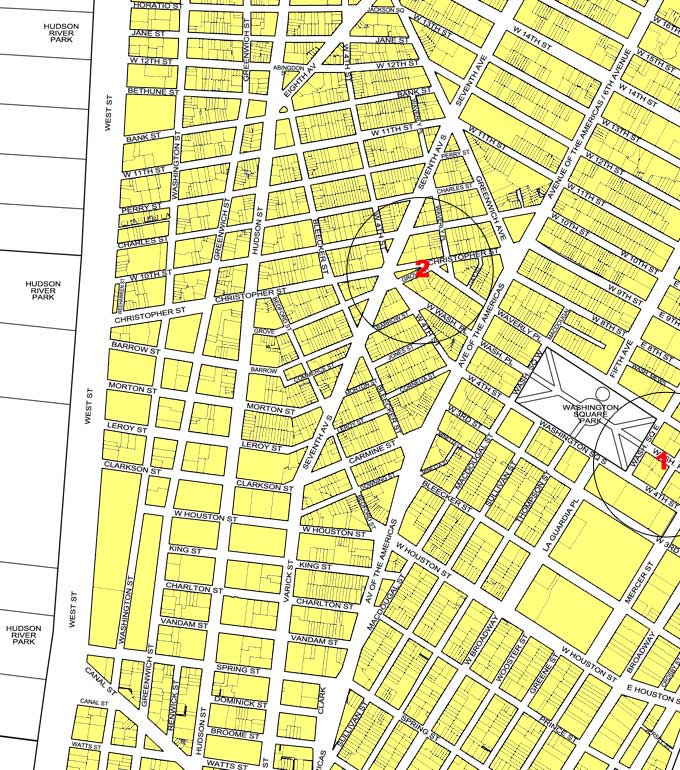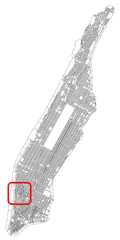Greenwich Village is located on what was once marshland. In the 16th century Native Americans referred to it as Sapokanikan ("tobacco field"). The land was cleared and turned into pasture by Dutch settlers in the 1630s who named their settlement Noortwyck. The English conquered the Dutch settlement of New Netherland in 1664 and Greenwich Village developed as a hamlet separate from the larger (and fast-growing) New York City to the south. It officially became a village in 1712 and is first referred to as Grin'wich in 1713 Common Council records. In 1822, a yellow fever epidemic in New York encouraged residents to flee to the healthier air of Greenwich Village, and afterwards many stayed.
Greenwich Village is generally known as an important landmark on the map of bohemian culture. The neighborhood is known for its colorful, artistic residents and the alternative culture they propagate. Due in part to the progressive attitudes of many of its residents, the Village has traditionally been a focal point of new movements and ideas, whether political, artistic, or cultural. This tradition as an enclave of avant-garde and alternative culture was established by the beginning of the 20th century when small presses, art galleries, and experimental theater thrived.
During the golden age of bohemianism, Greenwich Village became famous for such eccentrics as Joe Gould (profiled at length by Joseph Mitchell) and Maxwell Bodenheim, the dancer Isadora Duncan, as well as greats on the order of Eugene O'Neill. Political rebellion also made its home here, whether serious (John Reed) or frivolous (Marcel Duchamp and friends set off balloons from atop Washington Square arch, proclaiming the founding of "The Independent Republic of Greenwich Village"). In Christmas 1949, The Weavers played at the Village Vanguard.
The Village again became important to the bohemian scene during the 1950s, when the Beat Generation focused their energies there. Fleeing from what they saw as oppressive social conformity, a loose collection of writers, poets, artists, and students (later known as the Beats) moved to Greenwich Village, in many ways creating the East-Coast predecessor to the Haight-Ashbury hippie scene of the next decade. The Village (and surrounding New York City) would later play central roles in the writings of, among others, Jack Kerouac, Allen Ginsberg, William S. Burroughs, and Dylan Thomas, who collapsed while drinking at the White Horse Tavern on November 9, 1953.
Greenwich Village played a major role in the development of the folk music scene of the 1960s. Three of the four members of The Mamas and the Papas met there. Guitarist and folk singer Dave Van Ronk lived there for many years. Village resident Bob Dylan was one of the foremost popular songwriters in the country, and often developments in New York City would influence the simultaneously occurring folk rock movement in San Francisco, and vice versa. Dozens of other cultural and popular icons got their start in the Village's nightclub, theater, and coffeehouse scene during the 1950s, 1960s, and early 1970s, notably Barbra Streisand, Peter, Paul, and Mary, Simon and Garfunkel, Jackson Browne, Eric Andersen, Joan Baez, The Velvet Underground, Richie Havens, Maria Muldaur, Tom Paxton, Phil Ochs, Jimi Hendrix and Nina Simone. The Greenwich Village of the 1950s and 1960s was at the center of Jane Jacobs's book The Death and Life of Great American Cities, which defended it and similar communities, while critiquing common urban renewal policies of the time.
Greenwich Village was also home to one of the many safe houses used by the radical anti-war movement known as the Weather Underground. On March 6, 1970, however, their safehouse was destroyed when an explosive they were constructing was accidentally detonated, costing three Weathermen (Ted Gold, Terry Robbins, and Diana Oughton) their lives.
In recent days, the Village has maintained its role as a center for movements which have challenged the wider American culture: for example, its role in the gay liberation movement. It contains Christopher Street and the Stonewall Inn, important landmarks, as well as the world's oldest gay and lesbian bookstore, Oscar Wilde Bookshop, founded in 1967.



